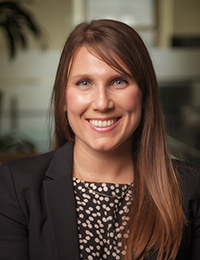Putting Children First: An Interview with MDRC’s Meghan McCormick About Child First Home Visiting

This Q&A was originally published by the Duke Endowment.
 Science tells us that unrelenting negative experiences — toxic stress — in early childhood affect a developing brain in ways that can herald lifelong learning and behavior problems. Conversely, research also shows that a stable, nurturing environment stimulates children’s brains in positive ways, priming them for better outcomes in life. Effective intervention can help mitigate or prevent those negative experiences and pave the way for healthy development.
Science tells us that unrelenting negative experiences — toxic stress — in early childhood affect a developing brain in ways that can herald lifelong learning and behavior problems. Conversely, research also shows that a stable, nurturing environment stimulates children’s brains in positive ways, priming them for better outcomes in life. Effective intervention can help mitigate or prevent those negative experiences and pave the way for healthy development.
In North Carolina, a promising program is working with vulnerable young children and caregivers by providing intensive, home-based services. Called Child First, the program provides support for adults and children together in their homes and connects them to the services they need. The goal is to stabilize families, help them build nurturing relationships, and improve the health and well-being of both caregivers and children.
With a $700,000 grant awarded in 2018, The Duke Endowment is supporting a randomized controlled trial of Child First in eastern North Carolina. Arnold Ventures, a philanthropic organization based in Houston, is providing additional support, including funding to study the program in Connecticut. MDRC is conducting the research in both states.
In the interview below, Meghan McCormick, an MDRC research associate who is directing the studies, explains more about evaluating this promising home visiting model and about finding a silver lining in COVID-19.
Q. Tell us about Child First. How does it differ from other home visiting programs?
Child First targets high-need families who have underlying challenges and traumas and provides intensive services that aren’t available in other home visiting models. The team includes a master’s-level clinician with experience in clinical psychology, mental health counseling, and/or social work, and a care coordinator. They serve as family partners and advocates.
The clinician provides Child-Parent Psychotherapy, helping the caregiver learn how to respond to a child’s needs in a sensitive and emotionally supportive way. They do role-playing activities and discuss ways to approach challenging situations. They provide mentoring and coaching sessions.
The care coordinator works with families to assess their needs and connect them to support and resources.
Q. You’re working on a second randomized controlled trial of Child First. What did the earlier study tell us?
That first randomized controlled trial was in Bridgeport, Connecticut. Researchers enrolled 157 families — half to the Child First program and half to the control group. It showed that the program improved children’s social-emotional skills and language development, reduced mothers’ depression and improved their psychological functioning, reduced family involvement with child protective services, and increased families’ connections to services and support.
Q. Why is this second study important?
The first study was small, and it was at only one site. The number of participants now is nearly four times larger and covers 10 sites.
Q. What is the goal?
To replicate findings from the initial study in multiple locations across two states and learn more about who benefits and how. With a larger sample, we can examine program impacts over a longer period and among subgroups of participants. This subgroup analysis can help policymakers and practitioners target the families most likely to benefit.
Child First has expanded significantly. It’s being offered in Connecticut, Florida, and North Carolina — and there’s a waiting list of families. Collecting longer-term outcome data would help the program’s chances of receiving federal funding and being available to more caregivers and children.
Q. Help us understand that.
Involvement in child protective services and dealing with the need for early intervention due to language delays and behavioral disorders is very expensive, so there’s a huge policy interest in trying to implement preventive interventions that can promote more positive outcomes.
Obviously, though, you want to make sure the support is going toward programs that are truly helping the families they are intended to help. Under the 2018 Family First Prevention Services Act, federal resources are now available for programs that reduce families’ involvement in child welfare systems. At least 50 percent of that money must be allocated to “well-supported” programs, which means participating in two RCTs that demonstrated positive impacts in one or more outcomes in a targeted domain. At least one of those outcomes must be long-term, or more than six months after the program ends.
By demonstrating positive impacts, we can help Child First become one of those well-supported programs. Increased federal funding will allow more families to access its services.
Q. Before the pandemic, you had recruited 226 families in the study from Connecticut and North Carolina. How did you pivot when stay-at-home mandates went into effect?
Everything was going as planned. Of those families, about 100 were from North Carolina. Then, obviously, we had to halt random assignment, and there was a two- to three-week period when very few families were receiving Child First services.
But shortly after that, the Child First teams began trying virtual visits. From our study, they had iPads for collecting data and they worked with families to make sure they could access a remote visiting platform.
Q. Is virtual delivery working?
We’re getting reports that sites have been pleasantly surprised with how well it’s gone, but it’s only anecdotal at this point.
Q. Will you add that to your study?
I think this is going to be a good learning opportunity for us. We’re going to do a more intensive implementation study about what virtual visits look like and how the Child First model may look different in the context of the pandemic. It’s also going to help us articulate some of the challenges and stressors caregivers and children have been experiencing.
Q. Can the RCT be restarted?
We are going to restart, but the pandemic has certainly changed our timeframe. We had planned to finish enrolling families by the end of 2020 and to report on all findings — including 12- and 36-month impacts — by the end of 2024. We now expect to enroll families through December 2022 and complete the full study by the end of 2026.
Q. Any surprises through all this?
The social service sector is often seen as slow to accept and adapt to innovative approaches. But the pandemic has demonstrated that in times of great need, we can be quick to change.
I’ve learned that we as evaluators, and also those providing direct social services, can be much more nimble to the needs of the people we’re serving and studying, and more adaptable to the challenges that inevitably come up in projects like this.





